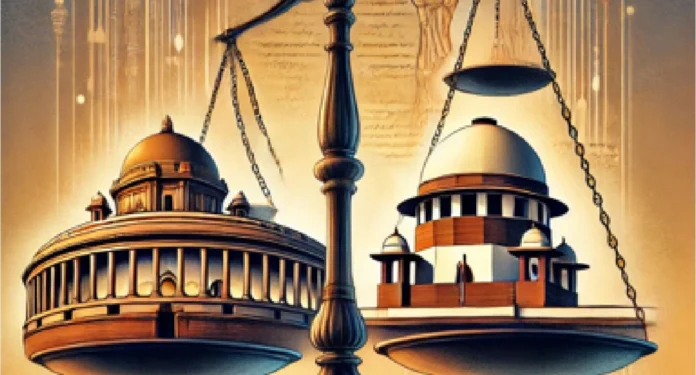By Sanjay Raman Sinha
The Supreme Court’s ruling in the Salwa Judum case has brought fresh clarity to the longstanding constitutional tension between the legislature and the judiciary. The Court held that a law passed by Parliament or a state legislature—subsequent to and contrary to a court directive—does not automatically amount to contempt of court. The ruling reinforces the idea that such legislation will have the “force of law,” unless it violates the Constitution’s basic structure or infringes on fundamental rights.
In effect, the verdict gives democratically elected governments the scope to correct or revisit policy directions issued by courts—provided they remain within constitutional bounds. But it also draws clear limits: the legislature cannot defy court orders with impunity, nor can it usurp judicial power.
This tension between legislative supremacy and judicial authority is as old as the Constitution itself. The doctrine of separation of powers is foundational: law-making is the preserve of the legislature, interpretation is the domain of the judiciary, and execution lies with the executive. Yet these realms often intersect—particularly when courts, under Articles 141 and 142, issue binding directives to secure complete justice. What happens when elected legislatures attempt to override or circumvent such directions?
In Salwa Judum case, a bench of Justices BV Nagarathna and SC Sharma made it clear: “An act of the legislature cannot be treated as contempt merely because it nullifies the basis of a judicial order, unless it is done in defiance of a court’s direction or seeks to usurp judicial power.”
Contempt of court, as defined by the Contempt of Courts Act, 1971, includes acts that scandalize or lower the authority of the court, or obstruct the administration of justice. But legislation—even if inconsistent with a judicial pronouncement—is not contempt, unless it deliberately defies a specific directive binding on the parties involved.
This position is rooted in constitutional logic. The Seventh Schedule provides legislatures with authority over specific subject matters. The judiciary cannot question the wisdom or intent of legislation as long as it stays within that legislative domain and respects fundamental rights.
Articles 141 and 142 equip the Supreme Court with broad powers. Article 141 ensures that its decisions bind all courts in India, while Article 142 empowers it to pass any order necessary to ensure justice. These Articles place the judiciary at the apex of legal finality. However, the legislature retains its sovereign power to legislate within its constitutional space—even if such laws override previous judicial directions.
Over the years, several flashpoints have illustrated this friction:
- Tamil Nadu’s NEET exemption attempts, despite the Supreme Court affirming NEET as a uniform national standard for medical admissions.
- Kerala’s amendment to university laws, diluting the governor’s powers after court rulings on vice-chancellor appointments.
- West Bengal’s move to replace the governor with the chief minister as chancellor, again following judicial interventions.
These cases underscore a pattern: when political will is strong, judicial rulings may be challenged by legislative action. While some see this as undermining the courts, others argue it reflects the democratic right of elected governments to chart policy course corrections in public interest.
The Supreme Court’s latest ruling doesn’t tip the scales in favour of one institution over another—it instead reaffirms the system of checks and balances that defines Indian democracy. It recognizes that the legislature and executive are sovereign within their respective spheres, subject to judicial review based on constitutional principles.
Importantly, the ruling firewalls legislative independence, affirming that governments can pursue alternative policy choices without automatically inviting contempt proceedings. At the same time, the judiciary remains the guardian of constitutional limits.
Ultimately, this verdict is not just a legal pronouncement—it is a constitutional reaffirmation. It protects the federal structure, validates the role of democratic institutions, and leaves ample room for negotiation, political manoeuvring, and institutional one-upmanship—hallmarks of any vibrant democracy.


